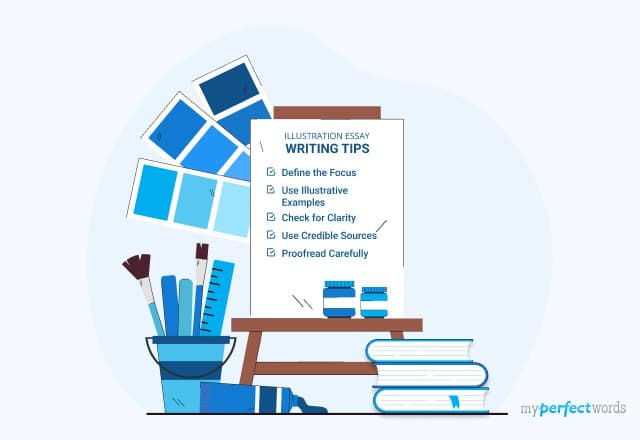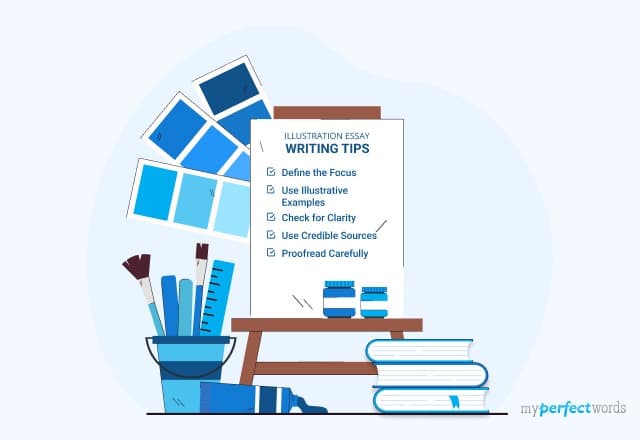An illustration essay is one of the most interesting essay assignments that you will get in your college and university life. It is a unique style of writing and very different from other types of academic essays.
A deep understanding of what exactly an illustration essay is and how to write a perfect one is important for success with this kind of work.
If you are new to illustration essays and don’t know how to start, our blog is here to help!
In this blog, you will find out how to write an illustration essay. You will also get a list of illustration essay ideas and samples to help you get started.
So let’s dive in!
On This Page![]()
- 1. What Is An Illustration Essay
- 2. How to Write an Illustration Essay?
- 3. Free Illustration Essay Examples
- 4. Illustration Essay Topics
- 5. Illustration Essay Writing Tips
What Is An Illustration Essay
An illustration essay is a type of essay that aims to present a compelling and vivid picture of a particular subject or personal experiences.
Unlike other essays that may focus solely on presenting arguments or analyzing data. An exemplification/illustration essay employs various examples, anecdotes, or scenarios to provide clarity and support for the chosen topic.
Purpose of Writing an Illustration Essay
The goal of an illustration essay is to paint a picture for the reader, helping them understand the subject through real-life instances or relatable situations.
This type of essay allows the writer to showcase their ability to express ideas in a relatable manner, making it an engaging and informative piece of writing.
In simpler words, think of an illustration essay as a bunch of pictures or examples that come together to create a clear and detailed image of the chosen topic. It's a way of making the subject more alive and easy to understand for the reader.
Check out this video to improve your understanding of illustration essays:
Read on to get a step-by-step guide on how to write one yourself!
How to Write an Illustration Essay?
Here is the step-by-step guide that you can follow for writing a great illustration essay:
Step 1: Choose a Topic
The first step is to choose an interesting topic for your essay. Make sure the topic you choose has enough material available online.
Step 2: Plan Your Writing
Once you have decided on the topic, start planning your essay. Find credible sources before starting to write your essay. In this way, you will have plenty of information and examples to include in your essay.
Step 3: Create an Outline
Create a rough outline to make the writing easier. Make sections for the introduction, body paragraphs, and conclusion, and write ideas you would add in each section.
Here’s a sample illustration essay outline:
I. Introduction
II. Body Paragraphs Paragraph 1
Paragraph 2
III. Counterargument (Optional)
IV. Conclusion
|
Step 4: Introduction & Thesis Statement
Here’s the answer to “How to start an illustration essay?”
The introduction is the opening paragraph that typically contains 5 to 10 sentences. The number of sentences in the introduction depends on the complexity of the topic.
The essay introduction should begin with a hook statement followed by some background information. End your introduction with the thesis statement.
It is important to include a well-written thesis statement at the end of the introductory paragraph. The thesis statement for illustration essay should reflect your point of view. It is basically a one-sentence statement that tells the readers what you will discuss in your essay.
Here is an illustration essay thesis example:
"Nature is amazing at overcoming challenges. This essay will show how plants grow through tough surfaces and how animals find clever ways to survive in the wild. We'll explore examples to see how nature always finds a way, no matter what obstacles come its way." |
Step 5: Developing the Body Paragraphs
This body section is typically made up of 3 paragraphs, but the number can be increased depending on the topic. In an illustration essay the body paragraphs should begin with a topic sentence followed by some supporting details and an example.
Make sure to include stronger evidence to support the thesis. The stronger the evidence is, the more seriously the reader will consider your point. Make sure the illustration you provide to support a point must relate to the subject and your audience.
You can also mention evidence in terms of importance, either from important to least important or from least important to the most important.
Step 6: Writing the Conclusion
Create a summary of the whole essay in the conclusion of the essay. Then, reiterate the thesis statement and include a finishing statement in the last.
Step 7: Add References
An illustration essay may require you to use empirical data and other research material. Don’t forget to state the sources on the final page of the essay. Follow the referencing style specified by your instructor.
Step 8: Proofread
Once you have finished the writing process, proofread your essay for any mistakes in grammar or structure. Edit and revise your essay to make sure it is free from any language mistakes.
Free Illustration Essay Examples
You can look at some professionally written illustration essay examples to better understand the correct writing style and tone for a great essay.
Here are some illustration essay examples that you can review before beginning the writing process.
Transition Words for Illustration Essay
Transition words and phrases are important to include for a smooth flow of information. However, students sometimes find it difficult to have a smooth transition in this type of essay.
Using transitions in your essay will make it easy for you to maintain a flow in your writing and for the readers to understand the connection in between.
Here’s a list of transition words and phrases that will come in handy for writing an illustration essay:
- For example
- For instance
- To illustrate
- Thus
- In other words
- As an illustration
- In particular
- The result that
- Consequently
- Hence
- Accordingly
- For this reason
- Therefore
- Because
- Since
- Due to
- As a result
Illustration Essay Topics
Choosing the right topic is the key point for writing an effective illustration essay. Below you can find some good illustration essay topic ideas for college to choose from.
- What are the best hobbies that can help you make money?
- Illustrate how a good education can lead to a successful life
- Explain your views on your favorite social media platform
- What is the most common challenge faced by Students today?
- What are the necessary steps for writing a resume?
- Rugby and football: Write about the main differences
- Status symbol and Fashion shows: Share your views with examples
- What are the most effective ways to save money?
- Write about the challenges currently faced by students
- Explain how movies impact our view of life
Looking for more great topics for your illustrative essay? Browse through our list of illustration essay topics!
Illustration Essay Writing Tips
Ready to start writing your illustration essay? Keep these tips in mind to make the process easier.
- Define the Focus of Your Illustration Essay:
Before you start writing your essay, it is important to clearly identify the focus of your illustration essay. This will help to ensure that you are able to effectively illustrate your points in an organized and concise manner.
- Use Illustrative Examples:
Make sure to include examples to support your points in your essay. These can be real-world examples that illustrate a point or hypothetical situations designed to show how certain aspects of the topic work.
- Check for Clarity:
Once you’ve finished writing your essay, read it over and make sure it’s clear and easily understood. If there are any areas of confusion or ambiguity, revise them to ensure the reader understands your point.
- Use Credible Sources:
If you’re going to include any facts or figures in your essay, make sure they are accurate and up-to-date. Before including them, make sure to check their credibility with reliable sources. This will help improve the authority of your essay.
- Proofread Carefully:
Finally, proofread carefully for grammar, spelling, punctuation, and other errors. Make sure to edit and proofread your essay before submitting it. This will help to ensure that your essay is as polished and professional as possible.
Refer to this illustration essay checklist to make proofreading easier:
Following these tips will let you write an excellent illustration essay. So be sure to keep these in mind while writing.
To conclude,
Hopefully, now you understand what an illustration essay is and the necessary steps for writing a perfect one.
If you are still unsure how to write a good illustration essay, get help from expert essay writers. MyPerfectWords.com is the go-to service if you want to pay for essay. We provide the best and most affordable essays, All you have to do is say 'do my essay cheap' and you can enjoy a quality paper without breaking the bank.
Hire our top essay writer and get the best illustration essay writing help from experts.

Write Essay Within 60 Seconds!
Use our AI tool to generate high quality essay-18976.png&w=256&q=75&dpl=dpl_GPBTQ81QWKukLBiP8kV5QyX2m3jE)
WRITTEN BY
Amanda M.
Columbia journalism grad writing speeches. I craft clear, quotable messages for media moments.


-10651.jpg&w=828&q=75&dpl=dpl_GPBTQ81QWKukLBiP8kV5QyX2m3jE)